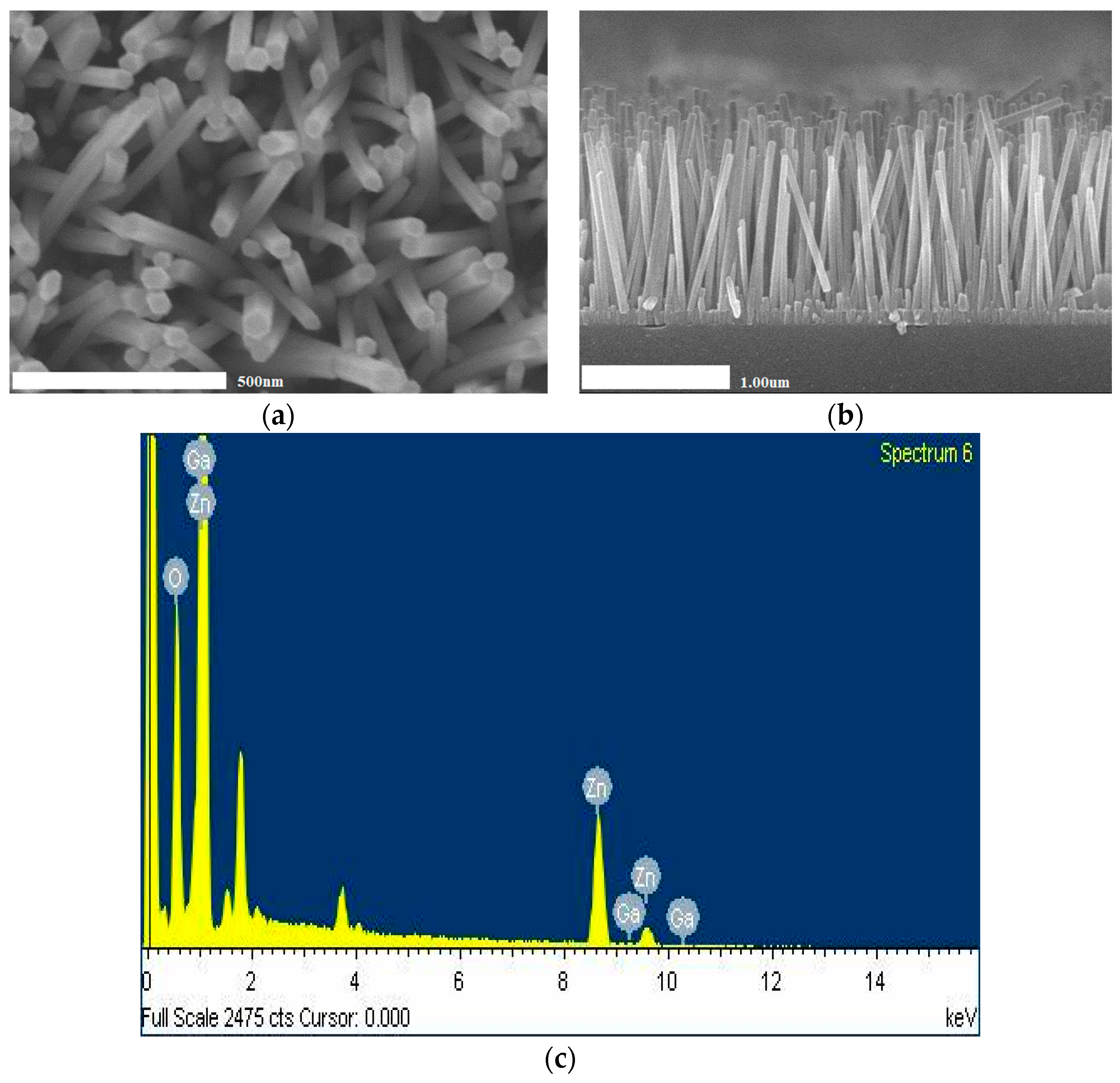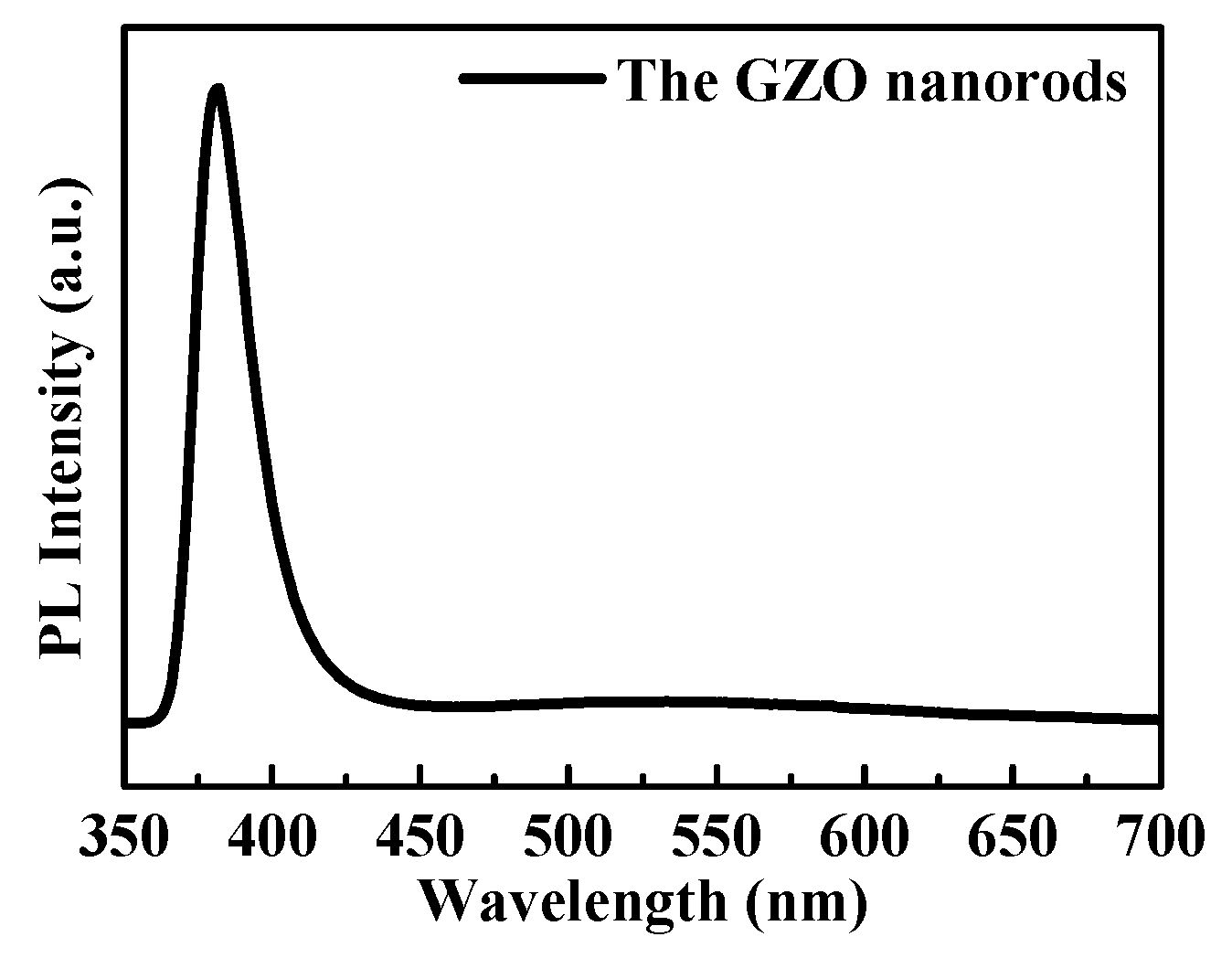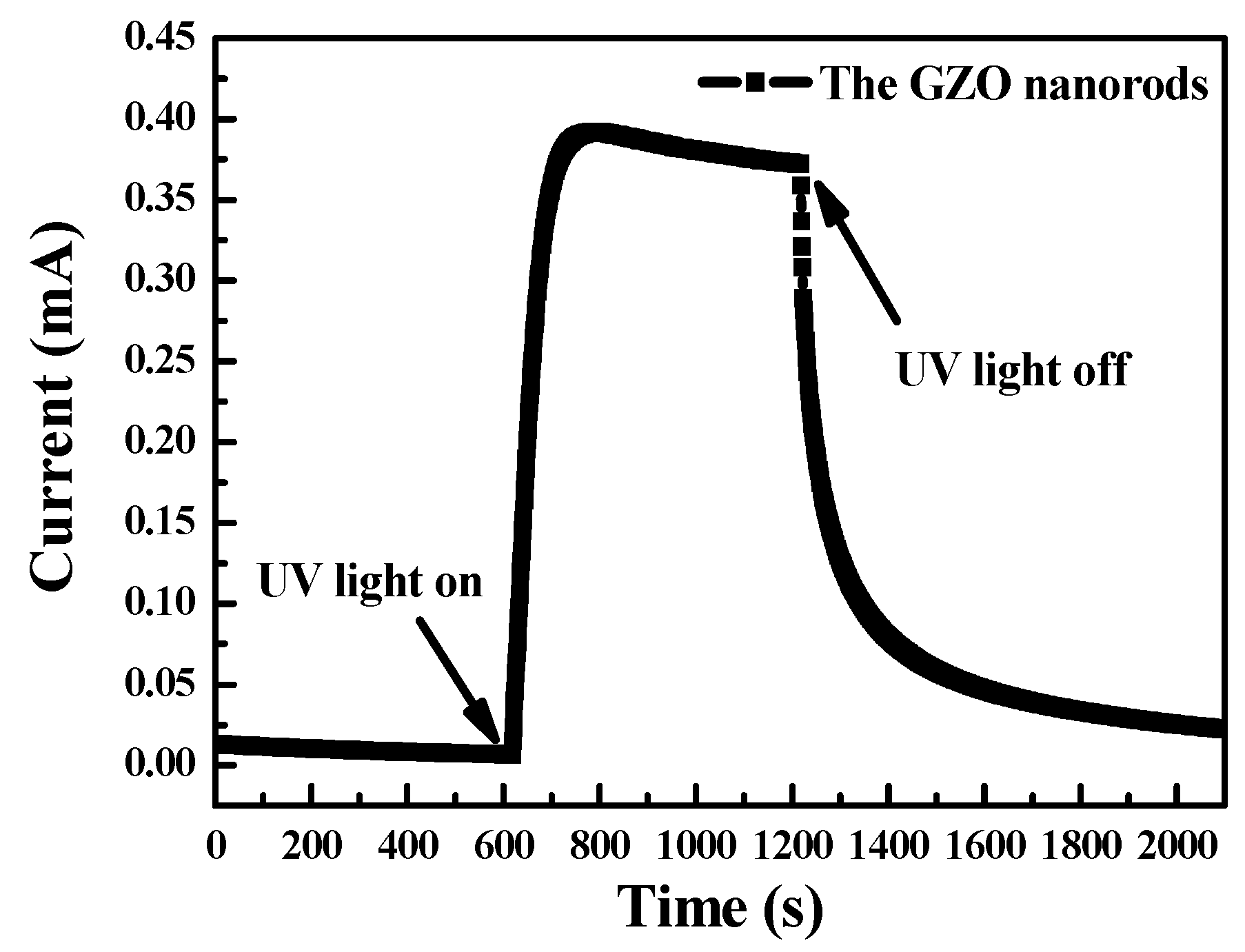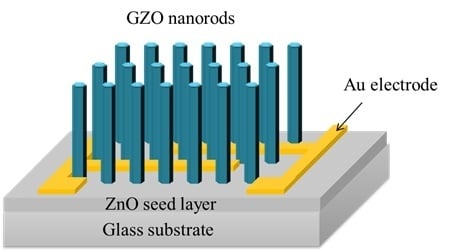Synthesis of Ga-Doped ZnO Nanorods by Hydrothermal Method and Their Application to Ultraviolet Photodetector
Abstract
:1. Introduction
2. Materials and Methods

3. Results and Discussion

| EDS | |||
|---|---|---|---|
| Element | O k | Zn L | Ga L |
| Ga-doped ZnO | 56.33% | 40.11% | 3.57% |



4. Conclusions
Acknowledgments
Author Contributions
Conflicts of Interest
References
- Ji, L.W.; Peng, S.M.; Su, Y.K.; Young, S.J.; Wu, C.Z.; Cheng, W.B. Ultraviolet photodetectors based on selectively grown ZnO nanorod arrays. Appl. Phys. Lett. 2009, 94, 203106-1–203106-3. [Google Scholar] [CrossRef]
- Ahsanulhaq, Q.; Umar, A.; Hahn, Y.B. Growth of aligned ZnO nanorods and nanopencils on ZnO/Si in aqueous solution: Growth mechanism and structural and optical properties. Nanotechnology 2007, 18, 115603-1–115603-7. [Google Scholar] [CrossRef]
- Kulkarni, A.J.; Zhou, M.; Ke, F.J. Orientation and size dependence of the elastic properties of zinc oxide nanobelts. Nanotechnology 2005, 16, 2749–2756. [Google Scholar] [CrossRef]
- Shen, X.P.; Yuan, A.H.; Hu, Y.M.; Jiang, Y.; Xu, Z.; Hu, Z. Fabrication, characterization and field emission properties of large-scale uniform ZnO nanotube arrays. Nanotechnology 2005, 16, 2039–2043. [Google Scholar] [CrossRef] [PubMed]
- Li, C.; Fang, G.J.; Su, F.H.; Li, G.H.; Wu, X.G.; Zhao, X.Z. Synthesis and photoluminescence properties of vertically aligned ZnO nanorod-nanowall junction arrays on a ZnO-coated silicon substrate. Nanotechnology 2006, 17, 3740–3744. [Google Scholar] [CrossRef]
- Wan, Q.; Li, Q.H.; Chen, Y.J.; Wang, T.H.; He, X.L.; Li, J.P.; Lin, C.L. Fabrication and ethanol sensing characteristics of ZnO nanowire gas sensors. Appl. Phys. Lett. 2004, 84, 3654–3656. [Google Scholar] [CrossRef]
- Liang, S.; Sheng, H.; Liu, Y.; Hio, Z.; Lu, Y.; Shen, H. ZnO Schottky ultraviolet photodetectors. J. Cyst. Growth 2001, 225, 110–113. [Google Scholar] [CrossRef]
- Huang, M.; Wu, Y.; Feick, H.; Tran, N.; Weber, E.; Yang, P.D. Catalytic growth of zinc oxide nanowires by vapor transport. Adv. Mater. 2001, 13, 113–116. [Google Scholar] [CrossRef]
- Choi, J.H.; Tabata, H.; Kawai, T. Initial preferred growth in zinc oxide thin films on Si and amorphous substrates by a pulsed laser deposition. J. Cyst. Growth 2001, 226, 493–500. [Google Scholar] [CrossRef]
- Ambia, M.G.; Islam, M.N.; Hakim, M.O. The effects of deposition variables on the spray pyrolysis of ZnO thin film. J. Mater. Sci. 1994, 29, 6575–6580. [Google Scholar] [CrossRef]
- Saito, N.; Haneda, H.; Sekiguchi, T.; Ohashi, N.; Sakaguchi, I.; Koumoto, K. Low-temperature fabrication of light-emitting zinc oxide micropatterns using self-assembled monolayers. Adv. Mater. 2002, 14, 418–420. [Google Scholar] [CrossRef]
- Lee, J.Y.; Choi, Y.S.J.; Kim, H.; Park, M.O.; Im, S. Optimizing n-ZnO/p-Si heterojunctions for photodiode applications. Thin Solid Films 2002, 403–404, 550–557. [Google Scholar] [CrossRef]
- Hsieh, Y.P.; Chen, H.Y.; Lin, M.Z.; Shiu, S.C.; Hofmann, M.; Chern, M.Y.; Jia, X.T.; Yang, Y.J.; Chang, H.J.; Huang, H.M.; et al. Electroluminescence from ZnO/Si-Nanotips light-emitting diodes. Nanoletters 2009, 9, 1839–1843. [Google Scholar] [CrossRef] [PubMed]
- Wang, H.H.; Baek, S.; Song, J.J.; Lee, J.; Lim, S.W. Microstructural and optical characteristics of solution-grown Ga-doped ZnO nanorod arrays. Nanotechnology 2008, 19, 075607-1–075607-6. [Google Scholar] [CrossRef] [PubMed]
- Hsiao, C.H.; Huang, C.S.; Young, S.J.; Chang, S.J.; Guo, J.J.; Liu, C.W.; Yang, T.Y. Field-emission and photoelectrical characteristics of Ga–ZnO nanorods photodetector. IEEE Trans. Electron Devices 2013, 60, 1905–1910. [Google Scholar] [CrossRef]
- Ma, S.; Fang, G.J.; Li, C.; Sheng, S.; Fang, L.G.; Fu, Q.; Zhao, X.Z. Controllable synthesis of vertically aligned ZnO nanorod arrays in aqueous solution. J. Nanosc. Nanotechnol. 2006, 6, 2062–2066. [Google Scholar] [CrossRef]
- Li, Q.C.; Kumar, V.; Li, Y.; Zhang, H.T.; Marks, T.J.; Chang, R.P.H. Fabrication of ZnO nanorods and nanotubes in aqueous solutions. Chem. Mater. 2005, 17, 1001–1006. [Google Scholar] [CrossRef]
- Wang, B.Q.; Xia, C.H.; Iqbal, J.; Tang, N.J.; Sun, Z.R.; Lv, Y.; Wu, L. Influences of Co doping on the structural, optical and magnetic properties of ZnO nanorods synthesized by hydrothermal route. Solid State Sciences 2009, 11, 1419–1422. [Google Scholar] [CrossRef]
- Hong, H.S.; Chung, G.S. Humidity sensing characteristics of Ga-doped zinc oxide film grown on a polycrystalline AlN thin film based on a surface acoustic wave. Sens. Actuators B: Chem. 2010, 150, 681–685. [Google Scholar] [CrossRef]
- Phan, D.T.; Farag, A.A.M.; Yakuphanoglu, F.; Chung, G.S. Optical and photoluminescence properties of Ga doped ZnO nanostructures by sol–gel method. J. Electroceram. 2012, 29, 12–22. [Google Scholar] [CrossRef]
- Ahn, C.H.; Han, W.S.; Kong, B.H.; Cho, H.K. Ga-doped ZnO nanorod arrays grown by thermal evaporation and their electrical behavior. Nanotechnology 2009, 20, 015601-1–015601-7. [Google Scholar] [CrossRef] [PubMed]
- Li, Y.B.; Valle, F.D.; Simonnet, M.; Yamada, I.; Delaunay, J.J. Competitive surface effects of oxygen and water on UV photoresponse of ZnO nanowires. Appl. Phys. Lett. 2009, 94, 023110-1–023110-3. [Google Scholar] [CrossRef]
© 2016 by the authors; licensee MDPI, Basel, Switzerland. This article is an open access article distributed under the terms and conditions of the Creative Commons by Attribution (CC-BY) license (http://creativecommons.org/licenses/by/4.0/).
Share and Cite
Young, S.-J.; Chiou, C.-L.; Liu, Y.-H.; Ji, L.-W. Synthesis of Ga-Doped ZnO Nanorods by Hydrothermal Method and Their Application to Ultraviolet Photodetector. Inventions 2016, 1, 3. https://doi.org/10.3390/inventions1010003
Young S-J, Chiou C-L, Liu Y-H, Ji L-W. Synthesis of Ga-Doped ZnO Nanorods by Hydrothermal Method and Their Application to Ultraviolet Photodetector. Inventions. 2016; 1(1):3. https://doi.org/10.3390/inventions1010003
Chicago/Turabian StyleYoung, Sheng-Joue, Chia-Lin Chiou, Yi-Hsing Liu, and Liang-Wen Ji. 2016. "Synthesis of Ga-Doped ZnO Nanorods by Hydrothermal Method and Their Application to Ultraviolet Photodetector" Inventions 1, no. 1: 3. https://doi.org/10.3390/inventions1010003
APA StyleYoung, S.-J., Chiou, C.-L., Liu, Y.-H., & Ji, L.-W. (2016). Synthesis of Ga-Doped ZnO Nanorods by Hydrothermal Method and Their Application to Ultraviolet Photodetector. Inventions, 1(1), 3. https://doi.org/10.3390/inventions1010003









